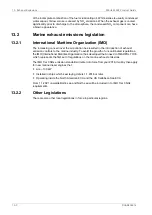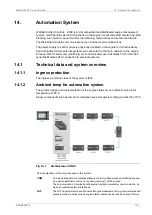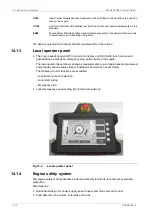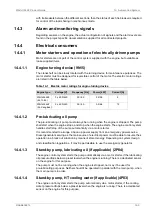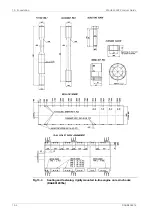
14.2.2
Stop and shutdown
A normal stop can be initiated locally, or remotely if applicable for the installation. At normal
stop the stop sequence is active until the engine has come to standstill. Thereafter the system
automatically returns to “ready for start” mode in case no start block functions are active, i.e.
there is no need for manually resetting a normal stop.
Emergency stop can be activated with the local emergency stop button, or from a remote
location as applicable.
The engine safety module handles safety shutdowns. Safety shutdowns can be initiated either
independently by the safety module, or executed by the safety module upon a shutdown
request from some other part of the automation system.
Typical shutdown functions are:
●
Lubricating oil pressure low
●
Overspeed
●
Oil mist in crankcase
●
Lubricating oil pressure low in reduction gear
Depending on the application it is possible to override a shutdown via a separate input. It is
not possible to override a shutdown due to overspeed or emergency stop.
Before restart the reason for the shutdown must be thoroughly investigated and rectified.
14.2.3
Speed control
14.2.3.1
Main engines (mechanical propulsion)
The electronic speed control is integrated in the engine automation system.
The remote speed setting from the propulsion control is an analogue 4-20 mA signal. It is also
possible to select an operating mode in which the speed reference can be adjusted with
increase/decrease signals.
The electronic speed control handles load sharing between parallel engines, fuel limiters, and
various other control functions (e.g. ready to open/close clutch, speed filtering). Overload
protection and control of the load increase rate must however be included in the propulsion
control as described in the chapter
.
14.2.3.2
Generating sets
The electronic speed control is integrated in the engine automation system.
The load sharing can be based on traditional speed droop, or handled independently by the
speed control units without speed droop. The later load sharing principle is commonly referred
to as isochronous load sharing. With isochronous load sharing there is no need for load
balancing, frequency adjustment, or generator loading/unloading control in the external control
system.
In a speed droop system each individual speed control unit decreases its internal speed
reference when it senses increased load on the generator. Decreased network frequency with
higher system load causes all generators to take on a proportional share of the increased total
load. Engines with the same speed droop and speed reference will share load equally. Loading
and unloading of a generator is accomplished by adjusting the speed reference of the individual
speed control unit. The speed droop is typically 4%, which means that the difference in
frequency between zero load and maximum load is 4%.
In isochronous mode the speed reference remains constant regardless of load level. Both
isochronous load sharing and traditional speed droop are standard features in the speed
control and either mode can be easily selected. If the ship has several switchboard sections
14-4
DAAB605814
Wärtsilä 46F Product Guide
14. Automation System
Summary of Contents for 46F Series
Page 1: ...Wärtsilä 46F PRODUCT GUIDE ...
Page 4: ...This page intentionally left blank ...
Page 8: ...This page intentionally left blank ...
Page 18: ...This page intentionally left blank ...
Page 86: ...This page intentionally left blank ...
Page 104: ...This page intentionally left blank ...
Page 154: ...This page intentionally left blank ...
Page 162: ...This page intentionally left blank ...
Page 170: ...This page intentionally left blank ...
Page 176: ...This page intentionally left blank ...
Page 194: ...This page intentionally left blank ...
Page 200: ...This page intentionally left blank ...
Page 202: ...This page intentionally left blank ...
Page 207: ...Fig 21 7 List of symbols DAAF406507 7 DAAB605814 21 5 21 ANNEX Wärtsilä 46F Product Guide ...









